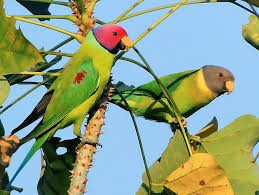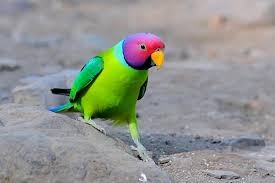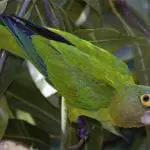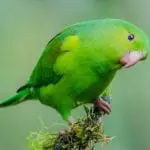Scientific Facts
| Scientific Name | Psittacula cyanocephala |
| Mass | 66g adult |
| Rank | Species |
| Higher Classification | Rose ringed parakeet |

Description
The plum-headed parakeet is a large green parrot, 33 cm extended with an end up to 22 cm.
The male has a red skull that shades to purple-azure on the posterior of the peak, nape, and cheeks, whereas the female has a blueish-gray skull. There is a thin black neck lapel with verdigris underneath on the nape besides a dark chin strip that spreads from the lower jaw. There is a red shoulder cover, and the rear and end are bluish-green, the last tipped snowy. The upper jaw is orangish-creamy, and the lower jaw is dim.
The female has a cloudy bluish-grey skull and lacks the dark and verdigris lapel, which is substituted by yellow. The upper-jaw is corn-yellow, and there is no dark chin strip or red shoulder cover. Young birds have an avocado head, and equally, jaws are yellowish. The dim head is learned after a year. The subtle bluish-red appearance, like the bud of a peach, is shaped by a mixture of azure from the visual effects shaped by the rami of the quill and red color in the barbules.
Some writers have careful the class to have two categories, the propose from projecting India (type area limited to Gingee) and the populace from the hills of the Himalayas as bengalensis on the foundation of the color of the cranium in the male which is redder and less sapphire. Newer works reflect the type to be monotypic.
The dissimilar head color and the snowy tip to the tail differentiate this class from the comparable blossom-headed parakeet (Psittacula roseata). The shoulder cover is maroon colored, and the shorter tail is tilted creamy in P. roseata.
A supposed type of parakeet, the so-called middle parakeet Psittacula intermedia, is supposed to be a cross of this besides the slaty-headed parakeet (Psittacula himalayana).
Habitat and Distribution
The plum-headed parakeet is a fowl of woodland and open forest, even in city parks. They are originated from the hills of the Himalayas south to Sri Lanka. They are not originated in the dry areas of western India. They are from time to time reserved as pets, and run-away birds have been renowned in New York, Florida, and some areas in the Middle East.
Behavior and Ecology
The plum-headed parakeet is an outgoing and noisy type with a variety of raucous noises. The usual flight and interaction noise are tuink? recurrent from time to time. The flight is rapid, and the bird frequently twists and goes rapidly. It makes resident movements, ambitious mostly by the obtainability of the fruit and flowers, which make up its food. They fodder on grains, fruits, the ample petals of plants (Salmalia, Butea), and occasionally raid agricultural arenas and woods. The breeding period in India is mostly from December to April and July to August in Sri Lanka. Courtship comprises bill rubbing and wooing feeding. It shells in holes, chiseled out by the couple, in bush trunks, and lays 4–6 white offspring. The female seems to be solely accountable for incubation and nourishing. They roost mutually. In confinement, it can learn to mimic honks and short whistling melodies and can dialog very well.
Neoaulobia psittaculae, a feather mite, has been labeled from the type. A type of Haemoproteus, H. handai, has been labeled from blood examples from the plum-headed parakeet.
Taxonomy
In 1760 the French zoologist Mathurin Jacques Brisson comprised a report of the plum-headed parakeet in his Ornithologie founded on an example collected in India. He used the French name Le perruche, a teste bleu, and the Latin designation Psittaca cyanocephalos. Though Brisson coined Latin designations, these do not imitate the binomial scheme and are not recognized by the International Commission on Zoological Nomenclature. Once in 1766, the Swedish biologist Carl Linnaeus efficient his Systema Naturae for the twelfth version; he added 240 types that had been before labeled by Brisson. One of them was the plum-headed parakeet. Linnaeus comprised a terse account, coined the binomial designation Psittacus cyanocephalus, and quoted Brisson’s work. The specific designation cyanocephalus/cyanocephala cartels the Ancient Greek disputes kuanos “dark-blue” and -kephalos “-headed.” This type is now located in the type Psittacula, which was presented by the French biologist Georges Cuvier in 1800.
Temperament
Their enjoyable nature makes them acceptable to additional birds when contained together in aviaries. Though, like another parakeet type, they can turn out to be violent throughout breeding seasons. Though these smart birds frequently learn to copy short whistling melodies, their talking aptitude is mediocre to the bigger parrot type. In confinement, they have an initial coyness and shyness, which can be distributed with good tenacious training and even contact. Notwithstanding being friendly, they do not like to be hugged by their owners.
Price
The value of a Plum-headed parakeet can be from $600 to $900.
Interesting facts
- These birds fly quickly by altering their instructions quickly with unexpected twists and goes while making a unique complete.
- Separately from flying, munching is a favorite activity of these energetic birds. They favor to plug on their swings, roosts, and other toys in confinement.
- In the previous, they were gathered with Psittacula roseate and were usually called as blossom-headed parakeets.
- These parrots are alike in scope to their companions, the African Ringneck and variety between 13 and 14 inches. It is significant to note that their colleagues, the Blossom-headed Parakeets, look very alike; though, they are two diverse species.
- The Plum Headed Parakeet is innate to India. These parrots flourish on flowers, fruits, and kernels. It is not rare for them to follow cyclical fruits, and many are contingent on well-known nourishing spots throughout the year.
- These birds are comfortable in open copses and woodlands. More lately, residents have been providing feeding positions as they are highly liked by the public and sightseers.
- In the rough, these birds flourish in great flocks. Their noises can be heard throughout the initial morning hours and just beforehand, sunset. Their shrill noises repeat across the firmament, and these parrots brand no effort to skin their influx. Their flocks can contain numerous birds or be segmented into lesser groups reaching between 5 and 10 parrots. Their swift and furtive drive makes them problematic to observe, and numerous can be seen dashing in and out of tight places.
- Throughout the breeding period, February through May, then once more in August through September, these parrot’s division off into couples. Apiece pair will find a nesting hollow in a sapling or a building corner or something alike where they will increase their young.
Breeding
Plum-Headed Parrots frequently reproduce in confinement, but are not measured “easy breeders.” The finest fallouts will be had by cover a pair alone in an outside aviary.
A female will characteristically crop 4-6 eggs, which she unaccompanied will hatch for 21-24 days. The male fodders her throughout this time, and he is too largely accountable for feeding the chicks as soon as they fledge (at stage 6 weeks). Fascinatingly, the female may continue in the shell for up to 3 weeks afterward the chicks have fledged – apparently feeling that “enough is sufficient”! The male will last to feed her throughout this “healing period.”
Plum-headed Parakeet in focus pairs on the nest infrequently develops the violent propensities shown by numerous additional breeding parrots. Somewhat, Plum-Headed Parakeets often recklessness rather than protect their nests if harassed. For that aim, active shells should not be reviewed.
Common Health Issues
Red Mites
A plague of red mites (Dermanyssus gallinae) reasons birds’ great uneasiness. The blood-sucking creatures are hard to spot with the naked eye, at fair 1mm max. They are too nocturnal, aggressive your animals at night. If unimpeded, the mites will soon spread plague sizes, and the subsequent blood loss may deteriorate your parrot’s resistant system and lead to secondary contagions.
One way of confirming the attendance of the tiny mites is to place the double-sided tacky tape in the corners, crevices, and angles of the aviary where the creatures fold in the daytime. The mites will get wedged on its shallow. Once you distinguish, they’re there, you need to unsoiled all in the birdcage methodically with hot liquid and a scrubbing brush, and retain checking and washing over the following few days pending they’ve gone.
Scaly Face Mites
The scaly face is produced by the minute skin-burrowing mite Knemidokoptes pilae. It mostly marks the bird’s care and beak; nonetheless, it can also reason difficulties in the legs and the vent part. The first symbol of the problem will be lengthy itching and rubbing. A brittle growth will finally appear on the cere, besides the beak will turn out to be distorted as the mite’s hole inside. Some facial fluffs may be mislaid. If untreated, the affected form parts will fall off, chief to severe handicap.
You need to interfere long beforehand; the problem spreads this dangerous phase. A visit to the vet is essential, where the birdie will be prearranged a right swab for treating the plague.
Scaly Legs Mites
This is produced by Knemidokoptes mutants, a counterpart of the flaking face mite. The bird’s legs swell and fleck excruciatingly. Medicinal paraffin is the usual action; nonetheless, you must speak with a vet first beforehand managing it.
Ticks
These blood-sucking beasts can reason anemia and even demise. They are frequently hard to spot, prowling beneath the plumages; nonetheless, once they’ve nourished, they will turn out to be blood-filled bags, the scope of a big pinhead. The ticks’ favorite spots are on cranium, neckline, or amid the nape and posterior.
They can be a problem if your birdcage is near to a forest or bush visited by deer. Ticks find a safe, cozy home-based in birdcages, and if you have an epidemic, you might have to option to a power hosepipe wash-down, a pesticide, and a new shingle and gravel (if that’s what your birdcage ground is completed from). The parrots will have to be detached, whereas the aviary scrubbing takes place.
Lice
These plume-eating pests (Mallophaga) are unusual in parrots; nonetheless, coop birds may clasp them from rough birds. The lice produce up to 3mm long; nonetheless, they can still hide effortlessly in a bird’s fluffs. The indications of infestation are fierce itching, frequent trembling of the fluffs, and, finally, a moth-eaten arrival, as the lice bite away at their host’s feathers.
A vet will be intelligent to treat the lice with an interaction chemical. Inappropriately, if one of your birds has them, the entire flock is perhaps diseased.
Worms
Cage birds can turn out to be diseased with Ascaris roundworm. These beings animate and breed in animals’ gluttons, and their offspring are passed on via mucks. The mature worms produce up to 3.5cm long, and numerous of these in birds intuitive can leak all the nutrients from its nourishment, producing severe undernourishment. In dangerous cases, there can be paralysis, nonetheless more frequently, the indications will be weight loss and lethargy. A vet will recommend a drug that flushes the worms out. The mature creatures will be noticeable in the bird’s mucks. The conduct will need recapping one or two weeks later to clasp the worms that lived as grubs in the parrot’s gut.
Roundworm is a specific problem in open-air aviaries, where mucks fall to the soil – a perfect home for the worm spawns. People can become verminous with the larvae, too, so swift action via vet-supplied medicine is significant.
Air Sac Mites
Parrots, lengthways with numerous other birds, have an internal organ named an air sac, a portion of their respiratory system. This is occasionally attacked by a tiny individual named the air sac mite. It likewise colonizes the bird’s trachea (the breathing pipe amid the gullet and the lungs). An invasion will distress the bird’s speech – his speech will sound hoarse, his toots will sound gruff, and he will start to brand a clicking, puffed sound when he respires. If left untreated, the fowl will finally suffocate.
A vet will be intelligent to treat the ill birdie, along with the rest of your herd – the air sac mite can feast very rapidly, and you have to shoulder that all the birds are diseased. This might not be clear, as it can take numerous weeks beforehand the puffed kicks in.
Allergies
A parrot can occasionally start self-plucking and self-packing as a consequence of a skin nuisance. This might be nourishment or some biochemical in the setting (detergents, household crops, etc.). Dividing the aggravation can be complicated, and it is value turning to the vet for skilled information.
Baldness
This can be transported by several different issues – self-plucking, pulling by another fowl, hormonal inequity, mineral lack, Psittacine Beak and Feather Disease (PBFD), feather mites or ringworm, or heredities. Cockatiels hurt from baldness more than another type, and heredities seem to play a big part in that detail.
Bleeding
When a parrot is rising new feathers throughout the molting period, or when new birds are creating their adult fluff, plume bleeding can happen. A new ‘pin’ quill covers blood vessels, deprived of which the full quill would not be able to produce. If these are injured throughout the initial days, they will bleed similar to any other wound.
Care Sheet

Positioning a Cage
Site is significant, as your birds will be spending ample – if not all – of their period in the birdcage. It needs to be anywhere neither too warm nor too cold. Kitchenettes must be evaded, as the numerous smokes from non-stick saucepans and gas hotplates can prove deadly to the less healthy members of the parrot household. You likewise need to evade revealing the birds to any housework product vapors, fly sprigs and other sprays, paint vapors, tobacco smoke, carbon monoxide from tanks and car exhausts, and slightly plug-in air freshener or perfumed candle. These belongings are all contaminants.
Cage Doors
Parrots are shrewd birds and will examine door-fasteners with intense attention. Some of the weaker designs can be unlocked by a tenacious parrot beak, so the entrance needs to be strong enough to endure these courtesies, or you will have to protect it with a small deadbolt.
Food Bowls
Having diverse feeding positions in birdcages helps verbose quarrels and glitches with territorial breeding birds who choose that all the nourishment is theirs! A good law of thumb is to deliver one container per bird and one additional. This gives everybody in the birdcage an excellent of nourishing places. Some can be on the birdcage floor, nonetheless most must be raised, or attached to the sides of the birdcage.
Water Bowls and Bottles
Water bottles are an effectual way of filling your birds’ liquid supplies. Open dishes and vessels are likely to get grubby very fast with mucks and bits of nourishment. This is acceptable as long as you retain an eye on the cleanliness and spotless the bowl frequently. The flask needs to be secured firmly to the side of the birdcage.
Parrot Perches
Diversity is important here. The parrot’s bottoms will be gripping a roost for considerable of the day, so diverse breadths and consistencies (the course the better, counting some pebble or real resting spots) will help retain feet and toes trained and supple. If the roosts and ledges in your parrot birdcage are uneven, you won’t need to concern about additional pedicure, though shops do stock ‘pedi-perches,’ and some salesmen will tell you that these are indispensable for keeping a parrot’s nails clipped. Parrots in the rough don’t need to purchase pedi-perches – the timber, pillar, and bark provided by countryside do that.
Parrot Food
Fruit, potatoes, nuts, kernels, a little additional protein in the procedure of cooked meat, and a base of particularly formulated parrot combination. That’s the foundation of most domesticated parrots’ foods. Nonetheless, there is no single food that outfits all kinds of parrot. It’s not just a substance of scope, either. Lories and Lorikeets fodder on nectar in the rough, Hyacinth Macaws are furious for nuts, and some class flourishes on a fairly carnivorous régime.
Food for Parrot Chicks
Occasionally called change foods, this is somewhat you might want to examine if you are hand-rearing chicks. Then, the parental birds will do the job deprived of you having to concern about obtaining and groundwork.
Parrot chick’s food on vomited food from their parentages in the initial days, nonetheless soon begin to complement this with scraps pecked from a hunk of fruit or vegetable, clutched in the parental bird’s beak or talons. If pretending this change nourishing, carrot, celery, fennel, or sweet potato sticks, or one or two broad beans knotted firmly together, do the work nicely. The goal is to impart the chick that there is additional to life than a broth of mashed up kernel and veg, and they will soon be prepared to fodder from a typical parrot feeding place similar to the adult birds.
Seed for Parrots
The quantity of kernel a parrot needs varies contingent on the type. One guise at a parrot beak in the act will express to you that it has changed exactly for opening kernels, grains, and nuts. The seed will procedure amid 15 and 50% of your pet’s food.
Availability and Where to Get One
There are specialized pet shops where you can buy such kind of parakeet today. There are also owners and even avian vets in your area, which you can get recommendations and referrals.
FAQs
Can plum head parakeet dialog?
When hand-fed as offspring, plum-headed parakeets can develop domestic and will bond powerfully with their owners. This fowl is less difficult of an owner’s period than numerous parrots, with a line of individuality.
What do plum headed parakeets consume?
Plum-headed parakeets usually eat additional fruit than further parakeets. Though, their food still comprises big quantities of seeds in totaling to fruit and nectar. These parakeets have been recognized to abolish crops when they reach in flocks of completed 100 birds.
How do you strain a plum headed parrot?
Plum-Headed Parrots frequently reproduce in confinement; nonetheless, they are not careful “easy breeders.” The best consequences will be had by covering a couple alone in an open-air aviary. A female will characteristically crop 4-6 eggs, which she unaccompanied will hatch for 21-24 days.


